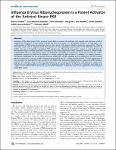Influenza B virus ribonucleoprotein is a potent activator of the antiviral kinase PKR
Dauber, Bianca
Martinez-Sobrido, Luis
Schneider, Jana
Hai, Rong
Waibler, Zoe
Kalinke, Ulrich
Garcis-Sastre, Adolfo
Wolff, Thorsten
Activation of the latent kinase PKR is a potent innate defense reaction of vertebrate cells towards viral infections, which is triggered by recognition of viral double-stranded (ds) RNA and results in a translational shutdown. A major gap in our understanding of PKR's antiviral properties concerns the nature of the kinase activating molecules expressed by influenza and other viruses with a negative strand RNA genome, as these pathogens produce little or no detectable amounts of dsRNA. Here we systematically investigated PKR activation by influenza B virus and its impact on viral pathogenicity. Biochemical analysis revealed that PKR is activated by viral ribonucleoprotein (vRNP) complexes known to contain single-stranded RNA with a 5'-triphosphate group. Cell biological examination of recombinant viruses showed that the nucleo-cytoplasmic transport of vRNP late in infection is a strong trigger for PKR activation. In addition, our analysis provides a mechanistic explanation for the previously observed suppression of PKR activation by the influenza B virus NS1 protein, which we show here to rely on complex formation between PKR and NS1's dsRNA binding domain. The high significance of this interaction for pathogenicity was revealed by the finding that attenuated influenza viruses expressing dsRNA binding-deficient NS1 proteins were rescued for high replication and virulence in PKR-deficient cells and mice, respectively. Collectively, our study provides new insights into an important antiviral defense mechanism of vertebrates and leads us to suggest a new model of PKR activation by cytosolic vRNP complexes, a model that may also be applicable to other negative strand RNA viruses.
Dateien zu dieser Publikation
Keine Lizenzangabe
Verwandte Publikationen
Anzeige der Publikationen mit ähnlichem Titel, Autor, Urheber und Thema.
-
2011-10-19ZeitschriftenartikelGrowth of influenza A virus is not impeded by simultaneous removal of the cholesterol binding and acylation sites in the M2 protein Thaa, Bastian; Tielesch, Claudia; Möller, Lars; Schmitt, Armin O.; Wolff, Thorsten; Bannert, Norbert; Herrmann, Andreas; Veit, MichaelInfluenza virus assembly and budding occur in the 'budozone', a coalesced raft domain in the plasma membrane. The viral transmembrane protein M2 is implicated in virus particle scission, the ultimate step in virus budding, ...
-
2009-04-24ZeitschriftenartikelExploring the functional interaction between POSH and ALIX and the relevance to HIV-1 release Votteler, Jörg; Iavnilovitch, Elena; Fingrut, Orit; Shemesh, Vivian; Taglicht, Daniel; Erez, Omri; Sörgel, Stefan; Walther, Torsten; Bannert, Norbert; Schubert, Ulrich; Reiss, YuvalBackground: The ALG2-interacting protein X (ALIX)/AIP1 is an adaptor protein with multiple functions in intracellular protein trafficking that plays a central role in the biogenesis of enveloped viruses. The ubiquitin ...
-
2010-01-20ZeitschriftenartikelCRK adaptor protein expression is required for efficient replication of avian influenza A viruses and controls JNK-mediated apoptotic responses Hrincius, Eike R.; Wixler, Viktor; Wolff, Thorsten; Wagner, Ralf; Ludwig, Stephan; Ehrhardt, ChristinaThe non-structural protein 1 (A/NS1) of influenza A viruses (IAV) harbours several src-homology domain (SH) binding motifs that are required for interaction with cellular proteins. The SH3 binding motif at aa212-217 [PPLPPK] ...

